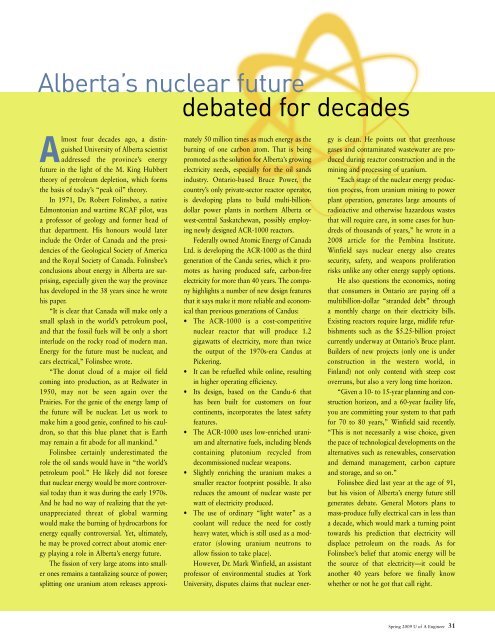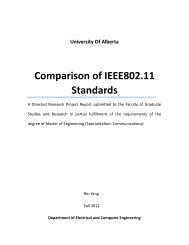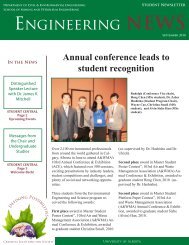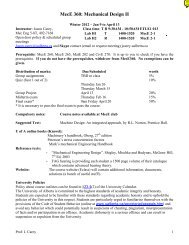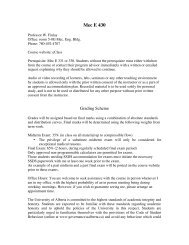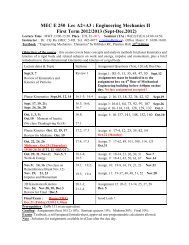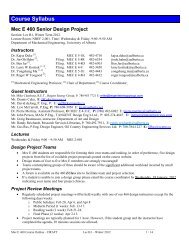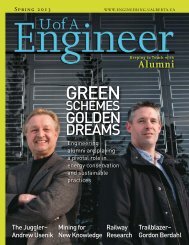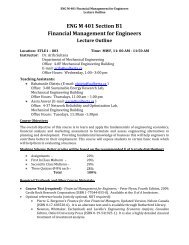Download - Faculty of Engineering - University of Alberta
Download - Faculty of Engineering - University of Alberta
Download - Faculty of Engineering - University of Alberta
Create successful ePaper yourself
Turn your PDF publications into a flip-book with our unique Google optimized e-Paper software.
<strong>Alberta</strong>’s nuclear future<br />
debated for decades<br />
Almost four decades ago, a distinguished<br />
<strong>University</strong> <strong>of</strong> <strong>Alberta</strong> scientist<br />
addressed the province’s energy<br />
future in the light <strong>of</strong> the M. King Hubbert<br />
theory <strong>of</strong> petroleum depletion, which forms<br />
the basis <strong>of</strong> today’s “peak oil” theory.<br />
In 1971, Dr. Robert Folinsbee, a native<br />
Edmontonian and wartime RCAF pilot, was<br />
a pr<strong>of</strong>essor <strong>of</strong> geology and former head <strong>of</strong><br />
that department. His honours would later<br />
include the Order <strong>of</strong> Canada and the presidencies<br />
<strong>of</strong> the Geological Society <strong>of</strong> America<br />
and the Royal Society <strong>of</strong> Canada. Folinsbee’s<br />
conclusions about energy in <strong>Alberta</strong> are surprising,<br />
especially given the way the province<br />
has developed in the 38 years since he wrote<br />
his paper.<br />
“It is clear that Canada will make only a<br />
small splash in the world’s petroleum pool,<br />
and that the fossil fuels will be only a short<br />
interlude on the rocky road <strong>of</strong> modern man.<br />
Energy for the future must be nuclear, and<br />
cars electrical,” Folinsbee wrote.<br />
“The donut cloud <strong>of</strong> a major oil field<br />
coming into production, as at Redwater in<br />
1950, may not be seen again over the<br />
Prairies. For the genie <strong>of</strong> the energy lamp <strong>of</strong><br />
the future will be nuclear. Let us work to<br />
make him a good genie, confined to his cauldron,<br />
so that this blue planet that is Earth<br />
may remain a fit abode for all mankind.”<br />
Folinsbee certainly underestimated the<br />
role the oil sands would have in “the world’s<br />
petroleum pool.” He likely did not foresee<br />
that nuclear energy would be more controversial<br />
today than it was during the early 1970s.<br />
And he had no way <strong>of</strong> realizing that the yetunappreciated<br />
threat <strong>of</strong> global warming<br />
would make the burning <strong>of</strong> hydrocarbons for<br />
energy equally controversial. Yet, ultimately,<br />
he may be proved correct about atomic energy<br />
playing a role in <strong>Alberta</strong>’s energy future.<br />
The fission <strong>of</strong> very large atoms into smaller<br />
ones remains a tantalizing source <strong>of</strong> power;<br />
splitting one uranium atom releases approxi-<br />
mately 50 million times as much energy as the<br />
burning <strong>of</strong> one carbon atom. That is being<br />
promoted as the solution for <strong>Alberta</strong>’s growing<br />
electricity needs, especially for the oil sands<br />
industry. Ontario-based Bruce Power, the<br />
country’s only private-sector reactor operator,<br />
is developing plans to build multi-billiondollar<br />
power plants in northern <strong>Alberta</strong> or<br />
west-central Saskatchewan, possibly employing<br />
newly designed ACR-1000 reactors.<br />
Federally owned Atomic Energy <strong>of</strong> Canada<br />
Ltd. is developing the ACR-1000 as the third<br />
generation <strong>of</strong> the Candu series, which it promotes<br />
as having produced safe, carbon-free<br />
electricity for more than 40 years. The company<br />
highlights a number <strong>of</strong> new design features<br />
that it says make it more reliable and economical<br />
than previous generations <strong>of</strong> Candus:<br />
• The ACR-1000 is a cost-competitive<br />
nuclear reactor that will produce 1.2<br />
gigawatts <strong>of</strong> electricity, more than twice<br />
the output <strong>of</strong> the 1970s-era Candus at<br />
Pickering.<br />
• It can be refuelled while online, resulting<br />
in higher operating efficiency.<br />
• Its design, based on the Candu-6 that<br />
has been built for customers on four<br />
continents, incorporates the latest safety<br />
features.<br />
• The ACR-1000 uses low-enriched uranium<br />
and alternative fuels, including blends<br />
containing plutonium recycled from<br />
decommissioned nuclear weapons.<br />
• Slightly enriching the uranium makes a<br />
smaller reactor footprint possible. It also<br />
reduces the amount <strong>of</strong> nuclear waste per<br />
watt <strong>of</strong> electricity produced.<br />
• The use <strong>of</strong> ordinary “light water” as a<br />
coolant will reduce the need for costly<br />
heavy water, which is still used as a moderator<br />
(slowing uranium neutrons to<br />
allow fission to take place).<br />
However, Dr. Mark Winfield, an assistant<br />
pr<strong>of</strong>essor <strong>of</strong> environmental studies at York<br />
<strong>University</strong>, disputes claims that nuclear ener-<br />
gy is clean. He points out that greenhouse<br />
gases and contaminated wastewater are produced<br />
during reactor construction and in the<br />
mining and processing <strong>of</strong> uranium.<br />
“Each stage <strong>of</strong> the nuclear energy production<br />
process, from uranium mining to power<br />
plant operation, generates large amounts <strong>of</strong><br />
radioactive and otherwise hazardous wastes<br />
that will require care, in some cases for hundreds<br />
<strong>of</strong> thousands <strong>of</strong> years,” he wrote in a<br />
2008 article for the Pembina Institute.<br />
Winfield says nuclear energy also creates<br />
security, safety, and weapons proliferation<br />
risks unlike any other energy supply options.<br />
He also questions the economics, noting<br />
that consumers in Ontario are paying <strong>of</strong>f a<br />
multibillion-dollar “stranded debt” through<br />
a monthly charge on their electricity bills.<br />
Existing reactors require large, midlife refurbishments<br />
such as the $5.25-billion project<br />
currently underway at Ontario’s Bruce plant.<br />
Builders <strong>of</strong> new projects (only one is under<br />
construction in the western world, in<br />
Finland) not only contend with steep cost<br />
overruns, but also a very long time horizon.<br />
“Given a 10- to 15-year planning and construction<br />
horizon, and a 60-year facility life,<br />
you are committing your system to that path<br />
for 70 to 80 years,” Winfield said recently.<br />
“This is not necessarily a wise choice, given<br />
the pace <strong>of</strong> technological developments on the<br />
alternatives such as renewables, conservation<br />
and demand management, carbon capture<br />
and storage, and so on.”<br />
Folinsbee died last year at the age <strong>of</strong> 91,<br />
but his vision <strong>of</strong> <strong>Alberta</strong>’s energy future still<br />
generates debate. General Motors plans to<br />
mass-produce fully electrical cars in less than<br />
a decade, which would mark a turning point<br />
towards his prediction that electricity will<br />
displace petroleum on the roads. As for<br />
Folinsbee’s belief that atomic energy will be<br />
the source <strong>of</strong> that electricity—it could be<br />
another 40 years before we finally know<br />
whether or not he got that call right.<br />
Spring 2009 U <strong>of</strong> A Engineer 31


